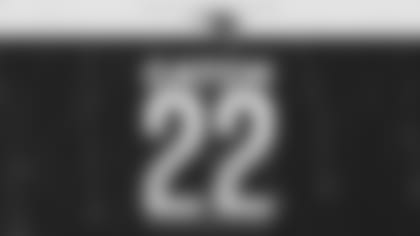The Patriots offense with quarterback Bailey Zappe has looked like a functional operation over the last three weeks, with New England winning two of its last three games.
Although he needed a mulligan in a shutout loss to the Chargers in his first start, Zappe has played winning football against the Steelers and Broncos, with a combined QBR of 62.4 out of 100 in those two wins. New England is also averaging 19 points over its last three games, an improvement from the 13.5 points the Pats averaged in Mac Jones's 11 starts this season.
| This Season, As Starters | Bailey Zappe | Mac Jones |
|---|---|---|
| EPA/Drop-Back | -0.18 | -0.13 |
| Total QBR | 41.6 | 37.1 |
| CPOE | +2.9 | -2.9 |
Statistically, Zappe has a slight edge over Jones as the Patriots starting quarterback. As someone who believed in Jones as an NFL starter, it's only fair to give Zappe his flowers for doing more with the same or arguably an even worse supporting cast. Zappe hasn't had Rhamondre Stevenson and was missing TE Hunter Henry and WR JuJu Smith-Schuster in Denver. Plus, the Pats offensive line continues to have injuries with Trent Brown limited, and starting left guard Cole Strange and top swing tackle Conor McDermott out for the season.
Despite a dicey situation, Zappe has made it work better than Jones. Really, Zappe's small six-start sample size has been better than Mac's for two years. But why? Why is the fourth-round pick from Western Kentucky outplaying the first-rounder from Alabama? There's an obvious reason: Zappe isn't mentally broken down by an eroding situation around him like Jones was in the end. However, there's another reason that comes to mind.
Going back to the draft, Jones was a rhythm-based passer who succeeded with good timing, accuracy, and quick decisions. Yes, he had unreal talent at Alabama. Still, Mac displayed many of those traits as a rookie. Zappe, on the other hand, has a little more gunslinger in him. Based on the eye test, the fact that Zappe's EPA per play (-0.18) is slightly worse than Jones's (-0.13) as a starter this season is surprising. But it speaks to the type of players these two quarterbacks are at their core.
To build around Jones, the Patriots needed to amplify his ability to play in structure by protecting him and getting high-end separators at the receiver positions. New England never did that, amplifying Jones's weaknesses of below-average arm talent and mobility. The Patriots need the quarterback to elevate the supporting cast rather than the other way around, but they had a first-round QB who was more of a hit for average guy than a home run hitter.
Although he won't be mistaken for having elite physical tools, Zappe is a better playmaker than Jones. On Sunday night, Zappe was most successful on longer drop-backs, completing 12-of-16 passes for 138 yards and a touchdown. Zappe's completion percentage over expectation of +24.7 on drop-backs with a release time over 2.5 seconds is the highest by a Patriots quarterback in a game this season. Overall, Zappe ranks eighth among 36 qualified quarterbacks in CPOE (+2.9) since taking over as the starter in Week 13.
With a shaky offensive line and inconsistent receiver separation, Zappe helps cover up those flaws in his supporting cast better than Jones. He's more agile in the pocket, a better off-platform thrower, and gives the Patriots production late in the down. Despite another high pressure rate (44.4%) from an offensive line that ranks dead-last in pass-blocking win rate and being short-handed at receiver, Zappe landed some punches that you can't imagine Jones landing in the same situation. Simply put, the Patriots needed a quarterback who could just make stuff happen, and Zappe has done that.
| Bailey Zappe, This Season | Passes Under 10 Air Yards | Passes Over 10 Air Yards |
|---|---|---|
| EPA/Drop-Back | -0.35 | +0.57 |
| Passer Rating | 71.8 | 128.2 |
| CPOE | -3.0% | +14.9% |
To be a viable NFL starting option moving forward, Zappe needs to improve his short-area accuracy to be more efficient in the quick game and against blitz pressure. With several errant and rushed throws, Zappe averaged 5.6 yards per attempt with an 87.8 passer rating against Denver's blitzes, compared to a 9.0 average with a 134.8 rating without blitzes. Zappe's issues getting the ball out on time and accurately in the short passing game were the main reasons the team released him over the summer. Now, it's making the Patriots offense too volatile because he's inconsistent in hitting the layups.
However, given their current flaws around the quarterback, the Patriots are better off with Zappe's playing style than Jones's at this point. New England needed a playmaker rather than a play distributor, so the operation is more productive with Zappe under center. To be clear, that doesn't mean Zappe is their guy. It would take a lotmore to begin advocating for that. But this is a commentary on how a recent camp cut is outplaying a former first-round pick for the 2023 Patriots. The future is a different story.
Here are our big-picture takeaways on the defense and quick-hit film notes from the Patriots win over the Broncos After Further Review:
Pass Rush Goes Deep Into Its Bag for Second-Highest Pressure Rate of the Season
When it comes to dialing up creative pressure on opposing quarterbacks, head coach Bill Belichick has been a trailblazer for pressure schemes over the years.
Although it's hard to credit one defensive coach with bringing modern pressure schemes to the NFL, Belichick's defense has certainly been at the forefront of the movement. This season, the Patriots rank fourth in creeper pressure rate (5.5%), mix their fair share of simulated pressures (1.5%), and have the second-highest rate of coverage plays in cover zero structures (8.1%).
Without top pass-rusher Matthew Judon, the Patriots are getting creative to find a pass rush. On Sunday night, the Pats had Broncos quarterback Russell Wilson flustered through three quarters with their second-highest pressure rate in a game this season (44.2%). New England sacked Wilson five times, including three by stud DT Christian Barmore, while ten different Patriots logged a quarterback pressure for 19 pressured drop-backs.
Before we get into some examples, let's explain the difference between a creeper pressure and a simulated pressure. With creepers, the defense doesn't show pressure pre-snap in a standard defensive structure. A simulated pressure shows pressure pre-snap, often with five or more defenders on the line of scrimmage. Then, one or more defenders drop off the line into coverage, while the defense will attack the pass protection where it's most vulnerable with a four-man rush.
As for cover zero, the defense will forgo a post-safety in man coverage to bring more rushers than the offense has blockers. At the same time, the Patriots also have rules within the rush plan to have defenders drop off into coverage once they draw a blocker.
Starting with cover zero, the Patriots called five all-out blitzes in Sunday's win for several reasons. First, rushing six defenders hurries Wilson into making quick decisions while covering gaps to prevent scrambles. Plus, the Pats also showed cover zero blitzes early to set up things later.
In this play, the Patriots put six defenders into the rush, with DB Jalen Mills blitzing from over the tight end. Most likely, safety Kyle Dugger would take the tight end from depth if he releases into the pattern. Since the tight end stays in to block, Dugger becomes a free defender to help to the crosser in the middle of the field. In the rush, Mills blitzes against the slide protection on the play-action scheme, causing pressure. Jahlani Tavai initially rushes, but when the left tackle engages him, he drops off into coverage and is on the scene to force a fumble.
After showing cover zero early, the Patriots started to get into their bag of simulated pressures.
Here, the Patriots have seven blitz threats on the line of scrimmage against seven potential blockers, but they drop out of cover zero into a cover two zone. Right tackle Mike McGlinchey has to peek inside at the snap to see if LB Marte Mapu is blitzing to block it inside out. Instead, Mapu and DB Jalen Mills drop into a two-man coverage structure. By the time McGlinchey gets his eyes back outside, LB Mack Wilson is already in the backfield in 3.17 seconds for a sack.
This time, the Patriots show pressure pre-snap again with six defenders on the line of scrimmage. Instead of blitzing the on-the-line players as Wilson probably expects, Mills jumps into the rush right at the snap. The coverage becomes a standard cover-one scheme with LB Ja'Whuan Bentley on the running back, Mapu on the tight end, and Mack Wilson becoming a low-hole defender to help the shallow crosser. Wilson gets rattled by the disguise and runs himself into a Josh Uche sack.
New England also used simulated pressure to get favorable matchups for emerging star Christian Barmore. Mapu lines up in a two-point stance over the tackle. With three over two on the right side, the Broncos have no choice but to block Barmore one-on-one with right guard Quinn Meinerz. Barmore uses a bull rush with an arm over finisher to register the sack.
Eventually, Wilson made plays against the Patriots defense in the fourth quarter, with an explosive on an extended play (47 yards to Mims) and the Broncos QB finally solved cover zero on a 21-yard touchdown to Brandon Johnson. Wilson deserves credit for finding answers late, but New England built its lead with one of its best pass-rushing performances of the season.
Quick-Hit Film Notes From Patriots-Broncos After Further Review
- DT Christian Barmore logged five quarterback pressures with three sacks (one strip-sack), a QB hit, and a hurry plus two run stuffs. His sacks came on a two-hand swipe move and bull rushes with arm over finishers. Barmore has taken the next step because his power in his upper body can now match his flexibility and first-step explosiveness. His maturation as a run defender to press-and-shed as a two-gapper has been exceptional to watch. #ProBowlVote
- Although it's not surprising the NFL's worst run defense found ways to stop the Patriots on the ground, New England's poor run blocking was the main reason for a 24% rushing success rate. Obviously, continuity is everything for the O-Line. They couldn't hold their double team blocks, struggled in one-on-one base blocks on the backside, and couldn't get much movement to the second level. Like other opponents game-planning the Pats rushing attack as the top priority, the Broncos blew up runs by running through gaps and attacking single blocks. There was some movement at the point of attack, but the periphery defenders caused problems.
- It was far from a finished product with Cole Strange, but the dropoff at left guard was a legit issue. James Ferentz, who is not an NFL player, and rookie Atonio Mafi combined to allow a strip-sack, QB hit, and three hurries while Mafi also struggled in the running game. Mafi has an NFL frame, but he's not yet ready to compete at this level. He lacks foot speed, needs better hand placement in the run game to sustain blocks, and got fooled twice by line stunts. He should be watching and learning at this point, not playing.
- Vederian Lowe (37 snaps) and Trent Brown (21 snaps) combined to allow six quarterback pressures with two blown run blocks at left tackle. Lowe was on skates on the opening strip-sack and would've been the story on that play if Ferentz hadn't one-up him and got beat multiple times on spin moves. Brown was too aggressive on a few occasions, getting beat badly by Zach Allen on a stuff (14:09 4th). For many of you, it's quarterback or MHJ, but left tackle is a major need, with Joe Alt and Olu Fashanu as two blue-chip tackle prospects slated for the top ten.
- Rookie RG Sidy Sow allowed three hurries with one on a stunt, one on a poor punch against a two-hand swipe, and another due to poor leverage. On the whole, Sow is putting out good enough film. He needs to keep working on picking up line movement and should bulk up in the offseason if the plan is to keep him at guard. He gets run through by power at times.
- C David Andrews continues to be rock-solid for this team. Andrews was superb in this game in pass protection, sniffing out several schemed pressures post-snap—great player and leader.
- RT Mike Onwenu allowed three quarterback pressures with a few technique lapses protecting his edge in this one. Onwenu couldn't reach a block on one of the third-and-shorts and lost his technique on three hurries (we put the sack on Zappe). Onwenu can hold up on the outside, but his issues redirecting in space still give me pause about it being a long-term thing.
- Rookie WR Demario Douglas is a breath of fresh air on film by Patriots wide receiver standards: bursty to create quick separation, varies speeds in releases like a savvy vet, and can create after the catch. The drop on a perfectly executed "bullet" concept out of the bunch was a minus play, but Pop is a part of the solution. His separation quickness is tremendous.
- WR DeVante Parker made two high-level catches on Patrick Surtain, which is no easy feat. Parker ran by Surtain for a 30-yard catch and then caught the back shoulder on the game-winning drive for his second explosive. It's not surprising that he's re-engaged since Zappe will give him chances vs. single coverage, but his film has been good the last few weeks, with several opportunities to get him the ball downfield.
- Zeke Elliott had one minus decision on a run play where the off-ball blitzer opened a gap that Elliott didn't see. But most of his lack of production in the run game was on the blocking, and he got what he could on several occasions. The pass-game contributions are a nice bonus, but the early drop was a catchable pass upon review.
- TE Pharaoh Brown is now 11-for-11. All he does is make big plays. This week, add a third down conversion and a 20-yard seam shot. Brown was also open clearing out a spot concept, but Zappe rushed the decision for a two-yard completion to Zeke. Pharaoh is always open.
- Savvy veteran route in the red zone by TE Mike Gesicki on his 11-yard TD. Gesicki continued to climb upfield to clear the third level of the defense before cutting across the back of the end zone. It was a big reason why there was a passing window for Zappe to fit it in there.
- WR Tyquan Thornton hasn't developed into the player the team had hoped when they drafted him 50th overall. But he's contributing on his schemed touches with a nine-yard end around and an 11-yard tunnel screen. The screen got them out of a 2nd-and-20 to set up the Gesicki TD. Sneaky big play in the third-quarter explosion.
- Rookie DE Keion White showed up on film in this one. White had a QB hit on a great flying cross-chop move, logged a hurry on a T/E stunt, blew up a run, and batted down a pass. His tools are extremely enticing if they can continue to develop his pass-rush toolbox and recognition against the run. This was as good as White has played all year.
- EDGE Josh Uche led the Patriots with six QB pressures, using his speed-to-power effectively to keep Wilson in the pocket on his sack. Uche also jumped inside the tight end trying to block him one-on-one for a flashy hurry. As we wrote last week, Uche's explosiveness is still there.
- LB Jahlani Tavai is a really solid football player. He made a heady play to drop out of the cover zero rush on his forced fumble, swam around a lead-blocking fullback for a run stuff, and logged a QB hit closing down Wilson's space on third down on DEN's opening drive – impactful player.
- CB Jonathan Jones might've given up a big play on a crosser if it wasn't for pressure on Wilson. Still, he was only targeted once on 27 coverage snaps and broke up a deep pass for a huge play late. Competitor.
- DB Myles Bryant did everything in this game: big PBU on Courtland Sutton, had a hurry on a creeper pressure, logged two stops, and returned punts. His missed tackle was costly, but Bryant wears many hats for this team and does a good job on defense.
- CB Shaun Wade was left out to dry by Steve Belichick's cover zero call on Johnson's 21-yard TD, but he has to make the tackle there. He also gave up a 13-yard completion to Jerry Jeudy in quarters that was too easy. Still, he had a great cover three drop on the initial play design on Mim's bomb, and the completion wasn't on him, while his near-INT was good coverage to stay on top of Jeudy's vertical route. Overall, it was not bad in 38 coverage snaps.
- LB Mack Wilson's speed to turn the corner is a legitimate problem for OTs with a strip-sack and a hurry. Ask Broncos RT Mike McGlinchey, who got caught with eyes inside on Wilson's strip sack.
- Pass Protection: Onwenu (three hurries), Mafi (three hurries), Sow (three hurries), T. Brown (three hurries), Lowe (three hurries), Ferentz (sack), P. Brown (hurry), Elliott (hurry).
- Coverage: Austin (3/2/50/TD), Wade (4/2/34/TD/PBU), Bryant (6/4/34/PBU), Bentley (5/5/30), Dugger (7/4/28/PBU), Tavai (4/4/27), Mills (3/3/27), Jennings (1/1/8), Mapu (1/0/0/PBU), Jones (1/0/0/PBU), White (batted pass).
- QB pressures: Uche (sack, QB hit, four hurries), Barmore (three sacks, QB hit, hurry), Wilson (sack, hurry), Bentley (QB hit, hurry), White (QB hit, hurry), Tavai (QB hit), Mills (QB hit), Bryant (hurry), Jennings (hurry), Wise (hurry).










































